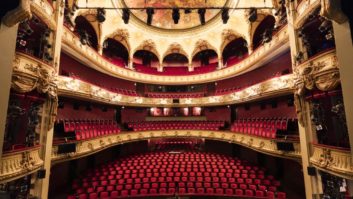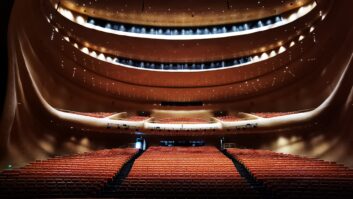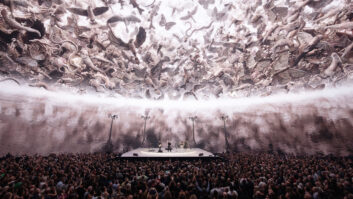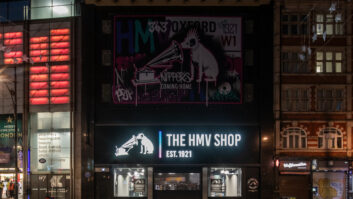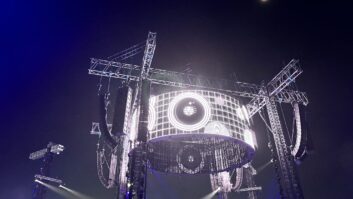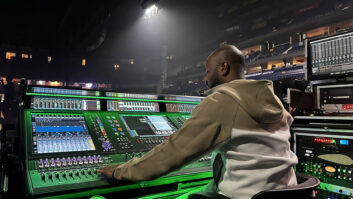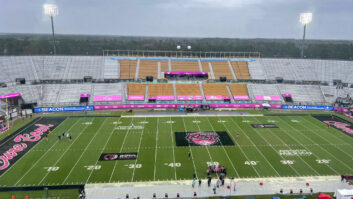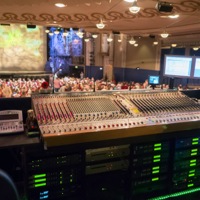
Every year, Installation magazine sister title PSNEurope undertakes a huge survey of the European live sound market in a special publication entitled PSNLive. Among many other trends, the last few surveys have highlighted a trend whereby – cognisant of the hugely diverse requirements of touring productions – some venues are inclined to lean more heavily on hired-in equipment stipulated on a per-event basis.
However, with a majority of facilities still electing to preserve a fulsome core audio spec, Installation set to wondering about essential requirements in several key areas for investment: microphones & personal monitoring, loudspeakers & amplifiers, consoles & networking, and broadcast applications. Among other issues, we wanted to identify the must-have features of a fixed PA system as well as the capabilities of an FOH console – particularly with the latter coming to assume the status of ‘hub’ for a networked audio installation.
For the purposes of clarity, Installation asked contributors to focus on mid-sized spaces of between 2,000 and 8,000 capacity that are used not just to host concerts, but other types of large-scale gatherings – for example, AGMs and conferences – and even sporting activities.
Microphones & personal monitoring
With name artists increasingly exacting about their microphone choices, it is understandable that by no means all concert venues will choose to invest in a substantial permanent inventory of microphones and personal monitoring systems. As Sennheiser’s product manager, microphones, Sebastian Schmitz, remarks, “at this size, you will have touring productions that bring their own equipment, or you will have the local rental company supplying all requirements as per the riders of the artists, which can of course differ to a great extent depending on the band, the instruments and personal taste”.
Those venues that do have a good set of basic equipment – such as small to medium-sized club venues – may have them on permanent loan from a rental company for a monthly fee. “Their inventory would include the most popular instrument microphones and also vocal mics, wired or wireless. Any missing equipment for a specific concert would be rented,” says Schmitz.
For those venues that do invest in a decent permanent collection, accommodating a variety of performance types is likely to be the chief priority. Joseph Wagoner, product manager, wireless tour sound – install at AKG, remarks: “They will need a set of microphones ranging from elegant high-quality condensers for opera vocal performance, to orchestral solo and section microphone applications, drum set mic systems, acoustic instrument microphones, wired handheld, wireless handheld and bodypack wireless systems.”
Primary tools in any permanent mic locker, continues Wagoner, are therefore destined to include “a large number of large-diaphragm condensers for orchestral sessions, grand piano, percussion, choir; a few small-diaphragm condensers to close-mic acoustic instruments such as guitar, banjo, mandolin; some dynamic handhelds for announcements, pop-rock vocals and stand-up comedy performers; dynamic instrument microphones to mic guitar cabinets, horn players, certain percussion types; and a drum set mic kit”.
Concert venues oriented primarily towards classical music are unlikely to have a substantial permanent inventory unless they are used frequently for recordings. In which case, says Schmitz, “they will look for studio condenser microphones that faithfully pick up the instruments with as much detail as possible, and have a wide frequency response that is able to capture the full sound of an instrument”. Increasingly, notes Schmitz, this is prompting venues to invest in digital wired microphones.
Whatever the type, mics must deliver “ruggedness, flexibility and fast set-up times”. They should also ensure longevity of investment – no small consideration given the impact of the global spectrum squeeze and frequency reallocation on PMSE (programme making & special events) users’ deployment of wireless mics and monitoring systems.
“The available spectrum has been or is being reduced, and venues that want to invest in wireless will need systems that are frequency-efficient and frequency-agile – in other words, can cover a large bandwidth to circumvent interference,” observes Schmitz.
Loudspeakers & amplifiers
The number and variety of loudspeaker solutions available to venue operators has never been greater. Despite this, however, the basic expectations for permanent installation tend to be fairly similar and are neatly encapsulated by Markus Schmittinger, Electro-Voice marketing manager, as “superb sound quality, controlled distribution of SPL, necessary high SPL, easy mounting and architecturally acceptable installation”.
At this point, the ability of line array solutions to offer high-quality, expertly targeted sound in what may be architecturally challenging spaces is such that they have achieved an eminent position in the concert venue market. But whether line arrays or more conventional point source speakers are felt to be appropriate, the multipurpose nature of many venues is such that systems need to be able to deliver high-quality reinforcement of music and speech.
“Flexibility from normal speech transmission over high-end music to voice evacuation is an absolute must in a modern environment,” says Schmittinger, who points to the recent specification of an Electro-Voice EVA line array system at Kultur- und Sporthalle Ertingen – “which is used for concerts, theatrical productions, balls, club and corporate gatherings, conferences and celebrations” – as a case in point (see case study, page 26).
With many venues feeling the pinch and an increased pressure on margins, it’s not surprising that self-powered solutions are on the rise. But whether or not venues choose to retain a ‘separates’ philosophy, flexibility and space/energy efficiency are bound to be near the top of the priority list.
“We believe that the increasing need for flexibility is a current trend that is produced by a general economic climate in which everybody is trying to optimise their budgets,” says Luca Giorgi, pro audio BU manager at Italian amplification specialist Powersoft. “In top shows/venues, attention to the quality of each single element of the audio chain has always been very high. However, recently the economic situation and energy-related factors have introduced a more cautious attitude in selecting an amplifier because it is the major source of power consumption in the audio chain…”
That translates to a firm focus on amps offering low power consumption, preferably delivered in as small a form factor as possible – “normally the space needed for hosting the equipment is considered a waste, and therefore the smaller the better”.
With in-house amps needing to accommodate permanent and visiting systems, multiple connectivity options are also important. A venue must therefore be “open in accepting a different PA system [to the] installed one when a specific tour is requesting it”, says Giorgi, adding that Powersoft’s K Series and Duecanali amplifiers are performing well in the concert venue segment.
Consoles & networking
For many mid-sized venues, purchasing an FOH console will represent their most substantial individual-unit investment. Adding to the pressure, there is the fact that, as DiGiCo sales application specialist Dan Page remarks, “a console is no longer just a mixing tool, but the heart of the audio infrastructure and installed audio network. As such, the chosen console should be able to manage the distribution of audio across the network and provide the best possible mixing capabilities.”
More of which anon – but what of the eternal requirements? Ben Millson, international sales manager at another leading console manufacturer, Cadac, identifies the must-haves as “high input and output channel count; great sounding EQ and comprehensive dynamics on each I/O channel; flexible bus channels (aux, group, matrix); multiple FX busses; advanced automation; easy- and quick-to-navigate UI; remote I/O and network connection flexibility; and, above all else, great sound quality.”
The miniaturisation trend that has seen DiGiCo, Soundcraft, Yamaha and many others launch compact desks means that this level of functionality can increasingly be delivered by a small form-factor digital console that allows venues to minimise the number of ‘lost’ seats. On its own terms, the console needs to be a powerful mixing device able to handle shows whose channel count may vary dramatically; as part of an installed audio network, it needs to be capable of “sharing the I/O resource and networking area”, remarks Page.
So for DiGiCo, he continues, this expectation has translated to “a high-speed low-latency optical solution that allows I/O to be shared, allocated and distributed around [multiple consoles and I/O locations]. This typically connects FOH, monitor and broadcast consoles into a single flexible audio network that runs hundreds of channels at 48kHz or 96kHz sampling rates.”
There should also be support for multiple formats to integrate with visiting systems, including those being used for broadcasting applications. Page points to the racks available for DiGiCo’s SD Series consoles, delivering as they do “complete 96kHz operation with downsampling and optical networking, and supporting a wide range of interfacing formats, including AES3, AES42, Dante and audio embedded within HD-SDI video”.
With many venues now waking up to the advantages of flexibly distributed audio – but with no one networking format yet to attain market dominance – accommodating multiple protocols is crucial. Surveying the current state of play, Millson offers a view that is highly typical.
“Networking has become an industry standard design requirement,” he says. “Having this flexibility is something that is required in both live sound and fixed installation applications, affecting I/O requirements, broadcasting, system expansion and personal monitoring systems. For Cadac it has meant that we are now looking to include support for a number of protocols, alongside our own MegaComms protocol.”
Broadcast & beyond
As our March issue’s houses of worship focus made clear, the whole post-event life of a performance – be it for live broadcast, subsequent streaming or online/physical release – is now increasingly important to revenue streams. For churches, this frequently translates to live streaming or broadcast on the growing number of religious TV channels; for concert venues, it means supporting artists who may wish to record concerts for instant-issue CD services or download release.
High-quality audio capture for subsequent distribution, agrees Millson, is “especially important these days with artists now making the most of their revenue from live performances”. This may prompt venues to invest in a dedicated hard disk system, such as Klark Teknik’s iconic DN9696, or even a dedicated console to handle broadcast feeds if activity levels justify the investment.
Recording capabilities along these lines can have other benefits, too, allowing engineers “to plan ahead with their shows with regard to having their settings in place by using the audio from a pre-recorded event to set up for the next one”, says Millson.
Thinking about broadcast applications is also leading some venues to invest in camera and video capture – as exemplifed by our case study on Helsinki Music Centre (see page 22), where Blackmagic Design solutions are allowing high-quality broadcast feeds to be delivered to Finnish state broadcaster YLE, among other customers. Across multiple interviews, the term ‘future-proofing’ was encountered on several occasions, and it is this requirement more than any other that is likely to inform venues’ future investments in permanent kit. With networking becoming a default, the focus will necessarily be on consoles and distributed audio solutions capable of ‘joining the dots’ in a coherent and flexible fashion that satisfies the requirements of today, tomorrow and – if possible – five or even 10 years hence.
www.akg.com
www.blackmagicdesign.com
www.cadac-sound.com
www.digico.biz
www.electro-voice.com
www.powersoft-audio.com
www.sennheiser.com
